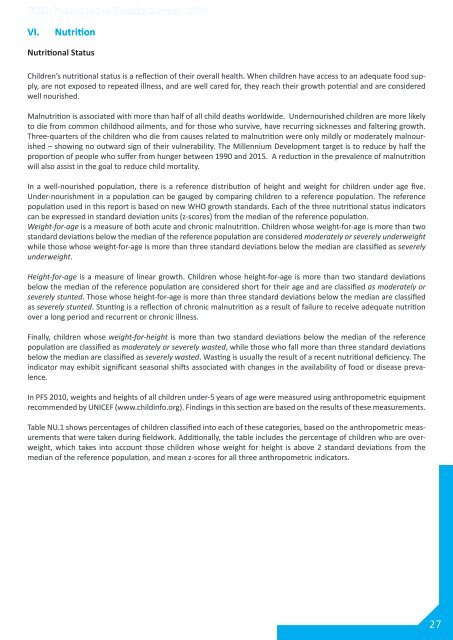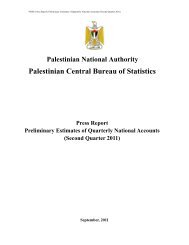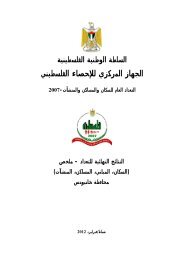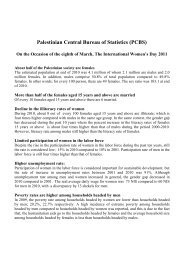Palestinian Family Survey 2010 Final Report - Palestinian Central ...
Palestinian Family Survey 2010 Final Report - Palestinian Central ...
Palestinian Family Survey 2010 Final Report - Palestinian Central ...
- No tags were found...
You also want an ePaper? Increase the reach of your titles
YUMPU automatically turns print PDFs into web optimized ePapers that Google loves.
PCBS: <strong>Palestinian</strong> <strong>Family</strong> <strong>Survey</strong>, <strong>2010</strong>VI.NutritionNutritional StatusChildren’s nutritional status is a reflection of their overall health. When children have access to an adequate food supply,are not exposed to repeated illness, and are well cared for, they reach their growth potential and are consideredwell nourished.Malnutrition is associated with more than half of all child deaths worldwide. Undernourished children are more likelyto die from common childhood ailments, and for those who survive, have recurring sicknesses and faltering growth.Three-quarters of the children who die from causes related to malnutrition were only mildly or moderately malnourished– showing no outward sign of their vulnerability. The Millennium Development target is to reduce by half theproportion of people who suffer from hunger between 1990 and 2015. A reduction in the prevalence of malnutritionwill also assist in the goal to reduce child mortality.In a well-nourished population, there is a reference distribution of height and weight for children under age five.Under-nourishment in a population can be gauged by comparing children to a reference population. The referencepopulation used in this report is based on new WHO growth standards. Each of the three nutritional status indicatorscan be expressed in standard deviation units (z-scores) from the median of the reference population.Weight-for-age is a measure of both acute and chronic malnutrition. Children whose weight-for-age is more than twostandard deviations below the median of the reference population are considered moderately or severely underweightwhile those whose weight-for-age is more than three standard deviations below the median are classified as severelyunderweight.Height-for-age is a measure of linear growth. Children whose height-for-age is more than two standard deviationsbelow the median of the reference population are considered short for their age and are classified as moderately orseverely stunted. Those whose height-for-age is more than three standard deviations below the median are classifiedas severely stunted. Stunting is a reflection of chronic malnutrition as a result of failure to receive adequate nutritionover a long period and recurrent or chronic illness.<strong>Final</strong>ly, children whose weight-for-height is more than two standard deviations below the median of the referencepopulation are classified as moderately or severely wasted, while those who fall more than three standard deviationsbelow the median are classified as severely wasted. Wasting is usually the result of a recent nutritional deficiency. Theindicator may exhibit significant seasonal shifts associated with changes in the availability of food or disease prevalence.In PFS <strong>2010</strong>, weights and heights of all children under-5 years of age were measured using anthropometric equipmentrecommended by UNICEF (www.childinfo.org). Findings in this section are based on the results of these measurements.Table NU.1 shows percentages of children classified into each of these categories, based on the anthropometric measurementsthat were taken during fieldwork. Additionally, the table includes the percentage of children who are overweight,which takes into account those children whose weight for height is above 2 standard deviations from themedian of the reference population, and mean z-scores for all three anthropometric indicators.27
















